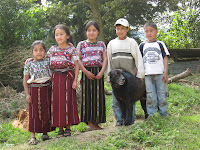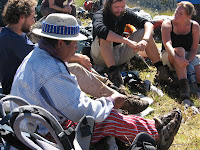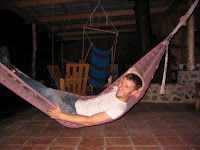
Around mid-October my daily commute through the cemetery began to get a little complicated. At first I didn't realize what was going on, so I simply slowed my pace to avoid the ever increasing number of swinging paint cans, wheelbarrows, shovels and rakes slung over shoulders. Little by little the cemetery began to bloom. Tombs displayed shiny new veneers, beautiful flowers and wreaths. High above the blue sky flashed with soaring plastic homemade kites. Walking my bike past picnicking families perched atop their dearly departed, I eventually connected the dots. Xela's living was readying its dead for what is now my favorite holiday here in Guatemala, El Dia de Los Santos, or All Saints Day, celebrated on November 1st.
In a country scattered with clandestine burial grounds and whose death toll reached a horrific 200,000 during the 36-year civil war, I can only imagine that for most Guatemalans celebrating El Dia de Los Santos is more than a little bittersweet. Still, the mood in the cemeteries is friendly and even festive. Families honor their deceased loved ones by flooding their resting places with life. Prayers are sung, candles are lit, and enterprising animals feast on the treats laid out for the dead to enjoy: tamales, oranges, and opened cans of soda.

Ethan and I honored Guatemala's ghosts in our own sort of way. Two weeks before the holiday hit we visited the ancient Mayan ruins of Copan, Honduras, climbing its crumbling staircases and gazing up incredulously at the gigantic ceiba trees and intricately carved stelae. On our first day in Copan we entered the park after 3 PM which allowed us to return the next day for a repeat visit. We wandered through the park well into the early evening, and as most of the other visitors drained out and the witching hour began to glow, I sat quietly watching the valley fill with wildlife. Squawking macaws filled the trees and a handful of other brightly colored tropical birds chirped elaborately. Far below, overgrown rainforest rodents chittered and fought, racing over the ancient altars. Looking out across the Copan valley and watching the light hit the rock shaped thousands of years ago by Mayan hands, it wasn't a huge leap to imagine a time when the kingdom was full of market noise and ball court battles.


A week later, taking our first break from volunteering, Ethan and I signed up for a seven-day trek with Quetzaltrekkers, an organization that donates all of its profits to a school for street kids here in Xela called SEDELAC. The trek took place in the Ixil Triangle, a remote area in the Cuchumatane Mountains, home to some of Guatemala's most remarkable natural beauty as well as some of its most brutal massacres during the civil war. Ethan and I had been looking forward to the trek for weeks, not only because we were eager to hit the trail and leave the city, but also because the trek happened to end on El Dia De Los Santos in a town called Todos Santos, where we had heard the festivities were approached from a uniquely lunatic angle. Our guide book promised that the day-long drunken horse race was not to be missed. But even our most wild imaginings of riders wearing long red cloaks and beating their poor horses with live chickens (!) could not eclipse the six days of beautiful trekking in the Cuchumatane mountains, or the fun we had with our 16 other fellow trekkers from all over the world.
 From Nebaj to Todos Santos we hiked through tiny towns, remote homesteads and spectacular countryside. Temperate rainforests gave way to interesting desert flora, and idyllic green valleys led up to impossibly craggy peaks. We visited a cheese farm, hiked by full moon to watch the sun rise over the mountains, and swam in the frigid early morning river. We slept in rural schools and ate dinner in families' homes. We sweated out our long days in Teamascals, or Mayan saunas, throwing hot water on the red hot coals and breathing slowly as our lungs clenched tight against the forbidding mixture of steam and smoke.
From Nebaj to Todos Santos we hiked through tiny towns, remote homesteads and spectacular countryside. Temperate rainforests gave way to interesting desert flora, and idyllic green valleys led up to impossibly craggy peaks. We visited a cheese farm, hiked by full moon to watch the sun rise over the mountains, and swam in the frigid early morning river. We slept in rural schools and ate dinner in families' homes. We sweated out our long days in Teamascals, or Mayan saunas, throwing hot water on the red hot coals and breathing slowly as our lungs clenched tight against the forbidding mixture of steam and smoke.


We met a lot of people along the way. Outside the cemetery in Nebaj we applauded as a graduate in cap and gown paraded past flanked by a sobbing mother and a beaming father, and a large extended family bringing up the rear. "Come to our house for tamales!" the father shouted.
Later, sitting inside the town's church Ethan and I accidentally crashed a wedding. No one seemed to mind so we stayed to watch as the bride walked down the aisle dressed in traje and a long white veil. On our way into the church I had noticed an older indigenous woman kneeling and crying in front of an altar just inside the church's entryway. We decided to leave before the "I do's" and so on the way out I stood where the woman had been kneeling. The altar was set back into the wall behind a large blue wooden cross. Behind the iron gate hundreds of small wooden crosses were fixed to the cement and scattered along the floor. Each bore a name and a date. A brightly colored painting hung above the gate depicting the plaza just outside the church's doors, but this scene was different: men, women and children were hog tied, blindfolded and bleeding. The altar was a memorial created to remember the innocent victims of the war. I scanned the crosses to find the most recent year: 1992 - just four years before the peace accords were signed.



Hiking through the foggy wilderness of the Cuchumatanes it was easy to see why the Guerilla Army used the Ixil Triangle as a base of operations; it must have been easy to remain hidden here indefinitely. Every now and then hiking past a fence or beneath a ridge I would look up in time to see a pair of quiet eyes fixed on mine. Sometimes the face would smile, but most often it would disappear quickly out of sight.

On our last day of trekking we summited La Torre, the highest non-volcanic point in Guatemala, with our host from the night before (pictured above in traditional Todos Santos traje). Sitting under the hot sun, surrounded by stunning views of the volcano chain, he told us his story, the story of his family and of his pueblo during the violence of the 1980s. Under the command of General Efrain Rios Montt, the fighting during the 1980s was particularly brutal and indigenous campesinos were regularly caught in the crossfire between left-wing rebel guerrilla groups and the Guatemalan army. Rios Montt is known for deliberately targeting thousands of indigenous Mayans who were suspected of harboring sympathies for the guerilla movement. Terrorized by regular acts of rape, torture and genocide, many indigenous populations, like the residents of La Ventosa, were persuaded to support the guerillas in exchange for protection from the Guatemalan army.
During one of the guerrilla army's regular visits to the town, many of the villagers of La Ventosa decided to add their names to the list of guerilla sympathizers. However, our host and his father remained ambivalent and ultimately decided not to join. After putting their names to paper, the residents followed the guerilla army's instructions agreeing to down power lines and destroy bridges in order to help disable the army's hold on the region.
Weeks later, our host was awakened before dawn to the sound of screaming. The army had some how gotten hold of the list of guerrilla supporters from La Ventosa and they were rounding up the entire village. Families and neighbors were forced to watch as one by one the guerrilla supporters were tortured and killed. One of the army's victim's that day was our host's uncle who was mistaken for someone else on the list by the same name. Because of an unfortunate scar his uncle had slicing his eyebrow, the army was convinced that he was not only a supporter but also a guerrilla commander. Despite the gruesome torture he was subjected to that day, his uncle miraculously survived, as did the man who shared his name. Our host expressed his grief and his anger at the guerrilla army for letting this happen to the people of La Ventosa. No one on the list had been protected. Later, stuck between the invisible protection promised by the guerrillas, and the terror committed by the army, many residents of La Ventosa agreed to join the army as civilian patrols. Once word spread to the guerrillas, they returned to La Ventosa to set and example. Like the army, they rounded up the civil patrolmen and lynched them in the town's center.
Hearing our host's story was of course heartbreakingly sad, but I was grateful for his candor and willingness to share it. I was grateful too for the way his teenage sons could sit on the mountaintop, aware of the tragic story their father was relating, but mostly enjoying the day and listening to their i-pods.
 Later that day we reached Todos Santos where the festival had already begun. We arrived at around 4 PM and men in traditional dress were either already passed out in the street from drinking or weaving around to the tinkle of marimba like zombies. We learned that during the rest of the year the bars are required by law to close early because of the widespread alcoholism in the town.
Later that day we reached Todos Santos where the festival had already begun. We arrived at around 4 PM and men in traditional dress were either already passed out in the street from drinking or weaving around to the tinkle of marimba like zombies. We learned that during the rest of the year the bars are required by law to close early because of the widespread alcoholism in the town.More than anything else, the festival was strange and sad. Like everyone else I went to watch the 12 hour horse race the next day and stood along the edge in the muck watching the men race back and forth, back and forth. As it turns out they thankfully don't use live chickens anymore to spur on their horses, but many of the riders were swilling beer, or riding hard and fast with their arms held out like airplane wings.

The crowd watched mostly in silence. There was no applause and no cheering. My nerves prickled with the knowledge that at any moment the worst might happen. And then it did. Around the middle of the day one drunken rider left from the wrong end of the track heading toward a line of charging horses at full speed. Two horses crashed with a god-awful sound and flopped upside down onto their backs. The riders lay still and the crowd surged around. Eventually the men stood up and the horses were led spastically out of the track. It's hard to imagine that the horses could have survived the collision. One indigenous woman turned to me and with rare emotion said, "They can kill themselves, but it's horrible - why do they have to kill the horses?"
The race continued for the rest of the day, and after the crash the spectacle seemed a little more subdued and the mood a little lighter. After experiencing the horror of the crash, what was left to fear?
 After the trek I have more or less continued at a break-neck pace. I biked to Zunil the day after we got back to Xela, saw the wooden Mayan deity San Simon, and then the next day I climbed volcano Santa Maria just outside Xela with Ethan, Fernando and Jose. The 4,500 foot climb was unrelenting but the views at the top were spectacular. We could see everything: the pacific shore, the volcanoes that jaggedly lead to the lake and Antigua, Tajamulco and, of course, the still active Santiaguito puffing away every forty-five minutes. Far away in the distance we could even see the Cuchumatanes covered in a blanket of cloud.
After the trek I have more or less continued at a break-neck pace. I biked to Zunil the day after we got back to Xela, saw the wooden Mayan deity San Simon, and then the next day I climbed volcano Santa Maria just outside Xela with Ethan, Fernando and Jose. The 4,500 foot climb was unrelenting but the views at the top were spectacular. We could see everything: the pacific shore, the volcanoes that jaggedly lead to the lake and Antigua, Tajamulco and, of course, the still active Santiaguito puffing away every forty-five minutes. Far away in the distance we could even see the Cuchumatanes covered in a blanket of cloud.




































